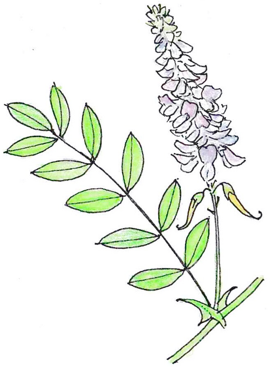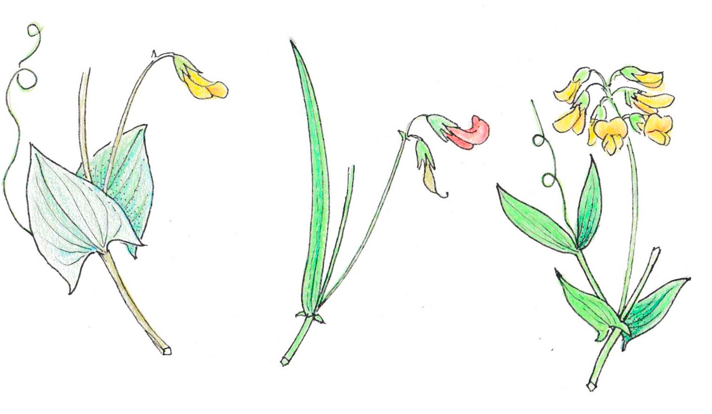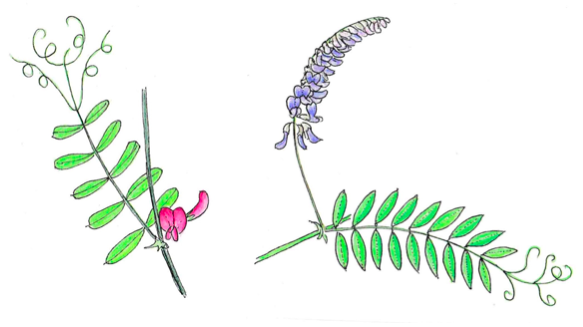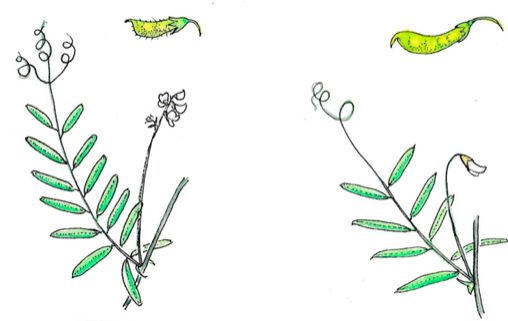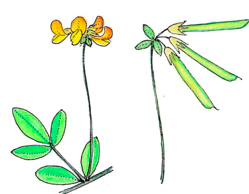There is a surprising number of different kinds of leguminous plants on Ham Lands. Several species are uncommon or rare in the London area. Most are attractive herbs but we also have bushy plants and trees. Several members of this family are native but others have been introduced, as fodder plants or ornamentals. Many species have nitrogen-fixing bacteria contained in root nodules; these help enrich the soil (not always good for biodiversity). We are lucky to have such a splendid selection of colourful, diverse and intriguing Legumes to study and enjoy.
Legumes all have:
- Pea-like flowers with special kinds of petals: – an upper standard, 2 wings on either side, and a keel (boat-shaped petal) sitting between the wings.
- Pods containing seeds, which resemble beans or pea-pods.
- Compound leaves (each leaf is made up of leaflets); stipules (often small triangular structures) found at the base of the leaf stem. The number of leaflets varies in different groups as does the size and shape of the stipules. Sometimes tendrils are present, in Legumes these are considered modified leaf structures. The kind of leaf helps with identification but in a few cases things can appear misleading and the explanations tricky. Don’t be put off; it can be intriguing.
Starting with herbs (i.e. non-woody plants) the Legumes found on Ham Lands are grouped, according to leaf types:
- many pairs of leaflets but no tendrils. Galega.
- 0 or 1 pair of leaflets and tendrils (absent in 1 tricky example). The genus Lathrus.
- more than 2 pairs of leaflets and tendrils. The genus Vicia.
- 5 leaflets, 1 pair at the base of the stem and 3 at the top; stipules minute – the genus Lotus.
- 3 leaflets and woody plants.
Many pairs of leaflets but no tendrils
Goat’s Rue – Galega officinalis
This introduced, invasive plant is extremely common. In the summer its massed flowers give a picturesque wash of colour to the Ham Lands. It is an upright plant (not sprawling like the Vetches and Vetchlings). It has many pairs of leaflets with a single leaflet at the top but no tendrils. There are many white, pinkish or mauve flowers per head. The pods are round. Flowering from June. The name Galega comes from the belief that, if fed to goats it would increase their flow of milk. ‘Rue’ comes from the resemblance of the leaves to the Rue plant, rather than goats would rue the day they ate it. Goat’s Rue is said to have many medicinal uses, but it can be harmful so do not be tempted to experiment.
0 or 1 pair of leaflets and tendrils
Vetchlings and everlasting peas (Lathrus)
These tend to be sprawling plants with square stems either angled or winged. They have 0–1(2) pairs of leaflets, most have tendrils. The pods are like small pea-pods.
Yellow Vetchling Grass Vetchling Meadow Vetchling
Yellow Vetchling – Lathrus aphaca. This rare native species is well represented on the HL South and easily recognised by its greyish foliage. Some explanation is required as it is one of the tricky examples: it has no leaflets, just a single tendril. The stipules are large and triangular-oval and function like leaves. The flower stalks bear only one yellow flower. Flowering from late May.
Grass Vetchling – Lathrus nissolia. This native species is relatively rare, but can usually be found at Ham, especially HL South. When not in flower it is hard to spot because the grass-like blades merge with the sward. Again it is a tricky example. The blade is actually a phyllode (a modified leaf-stalk), there are neither leaflets nor tendrils, and the stipules are minute. The dainty flower stalks are relatively long and bear 1–2 bright crimson flowers. Flowering from late May.
Meadow Vetchling – Lathrus pratensis. This native species is a relatively common, but attractive member of the HL flora. It has one pair of leaflets, tendrils are present and the stipules are arrow-shaped. There are 5–12 yellow flowers. Flowering from late May.
More than 2 pairs of leaflets and tendrils – the genus Vicia
Vetches and Tares – Vicia
These plants are normally sprawling to somewhat climbing, with round or ridged, un-winged stems. They have 3–15 pairs of leaflets, tendrils and small stipules. The pods are pea-like in miniature.
Common Vetch Tufted Vetch
Common Vetch – Vicia sativa subsp. segatalis. This common species is scattered throughout the Ham Lands and is the first to flower. It has 4–8 pairs of opposite leaflets. There are 1–2 magenta-purple flowers on a short stalk. Flowering time from April.
A similar species Bush Vetch - Vicia sepium differs by being a downy plant with broader leaflets, and 2–6 duller coloured flowers. It is very rare at Ham and has not seen recently.
Tufted Vetch – Vicia cracca. Culmps of this showy native species are frequently found at Ham. There are 8–15 pairs of leaflets. The blue-purple flowers are in heads of 10–40. Flowering from June.
A closely related species Fine-leaved Vetch – Vicia tenuifolia (differing by narrower leaflets and larger flowers with pale wings) has been recorded at Ham in the past.
The name ‘tares’ as in the Biblical – ‘separate the wheat from the tares’ – is commonly used for the following two species, although it can also be used for other Vicia species. You will notice that, now a days, these two species are considered to belong to different genera. The differences are slight and reasons are very academic and dull.
Hairy Tare Smooth Tare
Hairy Tare – Ervilia (= Vicia) hirsute. This small-flowered, common native species is abundant on the Ham Lands, and often found tangled with other plants. There are 4–10 pairs of dainty alternate (not opposite) leaflets; There are 1–9, white, mauve veined, flowers per stalk; the calyx teeth are all equal in length. The hairy pods are 2-seeded. Flowering from May.
Smooth Tare – Erevium (= Vicia) tetraspermum. This species is very similar to the Hairy Tare and the two often grow together. It has fewer (3–6) pairs of alternate leaflets; the tendrils are usually not branched (unlike our other 3 Vicia species). There are fewer (1–2), flowers per stalk, these are slightly bigger and pale blue to lilac with purple veins; the lower calyx teeth are longer than the rest. The hairless pods are 4-seeded. Flowering from May.
5 leaflets, 1 pair at the base of the stem and 3 at the top; stipules minute – the genus Lotus
Bird’s-foot Trefoils – Lotus
These plants are cushion-like or sprawling. The leaves are another tricky example. The basal pair of leaflets can easily be mistaken for stipules, leading to the mistaken impression of a trefoil (trifoliate) leaf. There are 5 leaflets, a basal pair and an upper three. The stipules are minute and hard to see. The flowers are grouped at the top of a slender stem above a small trifoliate leaf (or bract). The long, straight pods contain many seeds.
Common Bird’s-foot Trefoil
Common Bird’s-foot Trefoil – Lotus corniculatus var. corniculatus. This native, common, jolly looking species is low growing and often cushion-like. There are 3–8 flowers in each head; each flower is bright yellow with red markings, giving rise to the common name ‘Eggs and Bacon’. The more familiar common name ‘Bird’s-foot Trefoil‘ alludes to the resemblance to bird’s feet of the grouped pods. Flowering from June.
Alien Bird’s-foot Trefoil – L. corniculatus var. sativa. This introduced fodder plant is very similar to our native variety. It differs by being weakly erect, often with hollow stems and the flowers lack red colouration. Flowering from June.
Another rare native species, the Slender Bird’s-foot Trefoil – Lotus tenuis has been recorded in Ham Lands, North but has not been seen recently as far as we know. It is a more up right plant with distinctly narrower leaflets. The pale yellow flowers are fewer (2–4) per head. Flowering from June.
Text and drawing by Diane Bridson

